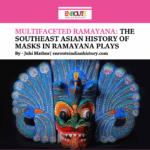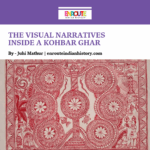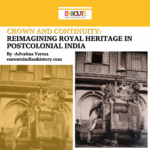Darbhanga’s Dazzling Jewels: Revisiting the Royal Collection
- EIH User
- August 1, 2024

Jewellery in India has always been integral to its cultural landscape. It has come to reflect religious significance as well as symbolizing royal wealth. One such royal possession of jewels and jewelry was in the royal state of Darbhanga, in Bihar. These royals were passionate about the way they adorned themselves and boasted a remarkable collection of priceless jewelry. Through revisiting this royal collection, one can comprehend the nature of luxury these Maharajahs of Darbhanga defined in the 20th century, altering the contours of Indian royal jewelry culture.
What comes to one mind when asked about the princely states of India? Nizams of Hyderabad, Kashmir state, Junagadh and perhaps a few would mention Patiala and Kapurthala. Amongst many of these princely states, there was one in Bihar, the Darbhanga Raj. This was the Khandavala dynasty of the region who were the largest landowners of Darbhanga and were among the most affluent ones in India. Isn’t it remarkable to take note of the fact that the last ruler of Darbhanga, of whom one might know very little, Kameshwar Singh was the third richest man in India in the mid-20th century? This historic royal jewelry collection, believed to be much more extravagant than other Indian royal family jewels such as the Nizam’s collection, began when these Maharajas of Darbhanga became bankers to local kings such as from places like Cooch Behar and Dumraon. But, in what way can these spectacular objects of ornamentation serve as an insight into the royal past? Well, it does and these art objects point toward the level of economic prosperity that a dynasty would’ve enjoyed in its heyday. Not only this, one can gauge the level of technological advancement and craftsmanship from these spectacular pieces of jewelry. These pieces also come to reflect the level of cultural exchanges between different cultural traditions in their art and design, which brings syncretism into the picture. Adornment with jewelry isn’t a recent practice but has been dominating the Indian cultural landscape right from the earliest times, when excavations dating to the ancient period, brought forth discoveries that reveal jewelry of different materials and sizes, only reiterating the significance of ornaments for Indian ancestors. Apart from indicating prosperous craft specializations and urban economy, these discoveries also indicate one’s status in the social hierarchy, based on the type and number of jewelry. Royal jewelry becomes reflective of the wealth that the rulers were able to amass amidst India whose contours were defined by years of colonial rule. These royal jewels further portray one of the areas where royal passions lie, in addition to the enhancement of regality. In the context of royal jewels being auctioned and celebrities spotted adorning some of the historic pieces, a revisit to the historic jewelry of Darbhanga, is worthwhile and relevant.

(Source- Peepul Tree World, Darbhanga royal jewelry treasury)
HISTORY OF JEWELRY IN INDIA
Before revisiting the Darbhanga royal family treasures, one must familiarize oneself with the history of jewelry in India, which denotes how significant these bejeweled pieces were in the past. India was the only global supplier of gemstones more than 2,000 years ago. For instance, the diamonds mined from Golconda, the sapphires sourced from Kashmir, and the pearls from the Gulf of Mannar are well known and attracted many merchants transcending international boundaries.
The history of the adornment of jewelry, as a symbol of economic security for women and a symbol of power and prestige for the royals, in India dates back to the prehistoric period when Neolithic sites like Mehrgarh (in present-day Pakistan) yielded jewel artifacts of lapis lazuli pendants with strings of the cylindrical shape of baked steatite beads. The Harappan Civilization in the Indus Valley also underlies the importance of jewelry in India. At this time, India was a big manufacturer and exporter of beads and the Harappan craftsman used semi-precious stones like agate, carnelian, faience, and steatite, making them into barrel or tubular shapes along with decorating them with various patterns and meticulously gold. The Harappans were sophisticated, as reflected in their jewelry showcasing excellent craftsmanship and engineering skills. One such example is a remarkable necklace from Mohenjodaro, lined with jade beads and agate pendants, that is suspended by a gold wire that passes through all these beads which are flawlessly drilled. Apart from spectacular technological prowess, the design also continued in the form of, for example, the Rajasthani borla, a forehead ornament, and also what the ancient Indian sculpture, Didarganj Yakshi wears in the middle of her forehead.
Jewelry was not the source of passion only for women but also for men. The sculptural remains in Bharhut, Amaravati, and Sanchi, and the Ajanta paintings showcase a wide range of ornaments worn by both women and men alike, and even kings and commoners adorned themselves too. A vibrant society dealing with precious stones like pearls and gold is described in the ancient Tamil Sangam classic Silappadikaram.
The ancient kingdom of the Shungas popularized ornaments in the shape of animals such as a pendant in the shape of a fish-tailed elephant. These two species were considered auspicious at that time.
One of the most remarkable discoveries attesting to the fine craftsmanship of the ancient Indian goldsmiths is a pair of non-identical earrings, generally associated with a Satvahana queen from Andhra Pradesh. This pair boasts elaborate carvings of emblems such as those of an elephant and a winged lion. Isn’t it curious to imagine how these large and heavy pendants and earrings would’ve been adorned by the early Indians? They would’ve done it in style as much as people in the present adorn themselves today. The two pieces of jewelry denote the aura and timeless legacy of ancient Indian royal jewelry.

(Source- The Metropolitan Museum of Art, A pair of royal golden earrings)
Foreign travelers too were astonished by Indian jewelry and one such Portuguese traveler, Paes describes these as worn by the people of the Vijayanagar Empire (in present-day Karnataka). Indian jewelry also holds importance for religious purposes and this temple jewellery was initially crafted to perfection to adorn the deities. Over time, dancers who wowed audiences with their mesmerizing performances with their devotional renditions too began to wear the imitations of the jewels meant for royalty. These pieces are chunky and large with deities gold fused or appearing in the pendant of pearl string necklaces. Rubies and emeralds were also utilized to create attractive patterns and some pendants of this kind also resemble the temple entrance or the ‘gopuram’ in their designs. Adorning oneself with this kind of jewelry also signified the wearers’s association with the Gods and the supernatural world. This belief is reiterated with the navratna, which is jewelry made of nine gems that are considered to be auspicious. These were mentioned in the ancient text of Garuda Puranam which describes gems like jade, sapphire, ruby, pearl, and emerald. These nine gems were symbolic of the deities of the Hindu universe. These were significant for astrological benefits and were worn by the Indian royalty.
Coming to the medieval period when the Mughal rule only bettered the artistic tradition of Indian jewelry. Their rule was important for the fusion of Indian and Central Asian styles and new patterns emerged with distinct levels of ornamentation, elegance, and extravagance. The Mughals also mastered the art of enameling in jewelry, where the reverse of each jewel is beautified with rich enamel work. The jewelry development in the Mughal period is reflective of precious metals being hammered with relief decoration and enameling, along with jade being encrusted with patterns. The Mughals also are popular for the technique of stem work of gold and stone leaves and flowers that gave rise to stunning pieces of art. Their jewels reflect colors of green, red, and white which is associated with the widespread use of emeralds, rubies, and diamonds respectively. If someone is under the impression that emeralds got popular only now, especially after the Ambanis family festivities, then that’s not true! Emeralds found their popularity in the Mughal era, whose emperors called them ‘Tears of the Moon’. One such emerald treasure is the Taj Mahal Emerald, an exquisite hexagonal-shaped emerald with intricate carvings of flowers that reflect the inlaid decoration of the Taj. Legendary India-mined diamonds include the infamous Kohinoor and the cursed rare blue diamond, the Hope Diamond which are symbolic in their ways to the witness of the tumultuous happenings from history.

(Source- The Better India, A 16th century Mughal pendant)
The Nizams of Hyderabad were also great connoisseurs of jewelry and boasted a remarkable collection. The last Nizam, Mir Osman Ali Khan, had an unimaginable collection of jewels and he also gifted a spectacular diamond necklace to the late Queen Elizabeth II of England when she was married to late Prince Philip. Before the American business magnate John Rockefeller acquired the Rockefeller Sapphire, this Burmese blue sapphire belonged to the Nizam. One of the remarkable collections from their jewelry treasure is head decorations or sarpech, worn by the Nizams as their turban ornament.

(Source- The Better India, Nizam’s Sarpech)
Furthermore, the Indian royal jewelry collection began to assimilate itself into the contours of colonial rule. The design from this period evolved from earlier traditions as well-known European jewelers like Cartier were commissioned to create timeless masterpieces for the Indian princely royalty. Examples of this jewelry include the Cartier-made necklaces for the Maharaja of Patiala (Punjab) and the Maharaja of Nawanagar (Jamnagar, Gujarat).
This brief journey into the history of Indian royal jewelry, in particular, lays out the context in which the royal Darbhanga state grew and gained popularity due to the now-lost royal jewels of Darbhanga.
DARBHANGA RAJ
Before paying a visit to the Darbhanga Maharaja jewels and after grasping a general idea of the history of Indian jewelry, it is necessary to understand the origins of this dynasty that captures one attention due to their historic royal jewelry collection.
This royal Khandaval dynasty was Maithil Brahmins who rose to prominence during the 16th century when Mughal emperor Akbar was ruling. This region of northern Bihar was in a state of political lawlessness when the Tughlaq dynasty (who had controlled Bihar) of the Delhi Sultanate ended till the rise of the Mughal Empire in the early 16th century. Post the decline of the Tughlaqs, various local Rajput claims were bidding for power in this region. Emperor Akbar of the Mughal Empire was quick to realize that to acquire and collect taxes from this region, there had to be a king in place to ensure peace, and to achieve this, he defeated the warring Rajput kings of Tirhut in 1574.
Local tradition goes on to say that the Mughal Emperor called Rajpandit Chandrapati Thakur to Delhi and instructed him to name any one of his sons who would be the tax collector and caretaker of Akbar’s lands in Mithila. Thakur named Mahesh Thakur, his middle son, whom Akbar declared as the ruler of the region on the auspicious day of Ram Navami in 1557. Mahesh’s great erudition impressed the Emperor. In the late 17th century, Emperor Aurangzeb issued a farman or royal decree that differentiated the Darbhanga Raj from other estates. This decree privatized the lands belonging to the royal family and the family were the permanent owners rather than being an imperial Mughal property. This estate was legally autonomous. To maintain their kingly status, they adopted the surname ‘Singh’. They made the Senas of Makwanpur in Nepal their vassals with the latter’s responsibility to pay tributes to the Maharajas of Darbhanga. These Maharajas utilized their military to assist the Nawabs of Bengal in battling rebellions from the chieftains of the Terai and the Banjaras. They denied, however, paying taxes to the Nawabs and this prompted Alivardi Khan in 1750 to send a force to war against the Maharaja of Darbhanga who was Narendra Singh at that time. The Darbhanga force defeated the Nawabi forces.
The colonial period of this dynasty was marked by its involvement in litigation regarding succession and the estate sought intervention from the Court of Wards because the colonial authorities tended to boost their economic position. The bureaucratic system introduced appointed officials who were strangers to the family and who resolved the issues suited to the interests of the owners, thereby disregarding the consequences for the tenants. This zamindari system was systematically abolished post-independence in 1950. Darbhanga’s last ruler, Maharaja Kameshwar Singh, also a member of the Constituent Assembly of India, passed away in 1962 without an heir.
This political context helps in the comprehensive understanding of the historic jewels and jewelry that were once part of the royal treasury of the Darbhanga Raj.
DARBHANGA ROYAL FAMILY TREASURES
What connects the Peshwas of Maharashtra, Queen Marie Antoinette of France, and the Mughals? Well, it’s not too hard to guess- it’s the Darbhanga Maharaja jewels! It’s time to revisit briefly these lost royal jewels of Darbhanga, after acquainting oneself with the general history of the development of Indian jewelry and the political context of the Darbhanga Raj.
The Peshwas served as the prime minister in the Maratha Empire. This office became hereditary post the demise of the fifth Chhatrapati, Shahu I in the mid-18th century. However, during his reign itself, the office grew powerful and served as the de facto ruler of the Maratha Empire. Peshwa Bajirao I (1700-40), was the most powerful Peshwa of the Maratha Empire, who was just twenty when he acquired a reputation for his decision-making powers and being military adventurous.
Peshwa Bajirao I was the original owner of the Naulakha Haar who got it created for 9 lakhs (hence the name). After him, every subsequent generation contributed more jewels, making this timeless piece worth Rs 90 lakhs in the 20th century. This royal jewelry, among the Indian royal family jewels, is a long necklace adorned with emerald, pearls, and diamonds. Post the revolt of 1857, defeated Nanasaheb Peshwa (adopted son of Peshwa Bajirao II and led the revolt in Kanpur) took this fabulous necklace with him to Nepal, where he sold it to the prime minister of Nepal, Rana Jung Bahadur for a tiny amount. This Nepalese virtual ruler took out all the chief gemstones- rubies and emeralds and reduced the size of the necklace.

(Source- Facebook- Peepul Tree World, Naulakha Haar)
This fabulous necklace finally landed as a part of the historic royal jewelry collection of Darbhanga, in 1901, when one of Rana’s successors Dhir Shamsher Rana sold it to the Maharaja of Darbhanga, Rameshwar Singh, who could only afford the necklace at that time. It is said that the latter paid the former in cash as the Nepalese prime minister was short of money and needed it urgently. Naulakha Haar was not the only Peshwa piece to form a part of the historic jewelry of Darbhanga. The Darbhanga Maharaja also acquired a single emerald, measuring 3 inches, the ‘Shiromani’ which Nanasaheb ascended as a seal, and a large diamond, the ‘Peshwa diamond’, which is described as that of the purest white.
Marie-Antoinette (1755-1793) was the Queen consort from Austria of King Louis XVI of France. She is associated with the decline of the French monarchy as her extravagant lifestyle served as a minor cause of the financial instability of the empire. Wider discontent against the monarchy led to the path-breaking French Revolution, which overthrew the monarchy, and the Queen and the King were eventually guillotined.


[Source- (L-R)- Alamy, Marie-Antoinette’s Diamond Necklace, Peepul Tree World, Antoinette’s daughter Marie Therese adorning a copy of the necklace]
This infamous Queen of France received an exquisite diamond necklace as a part of her wedding present during her wedding in 1770. This royal necklace passed into the ownership of the Habsburgs of Austria. This dynasty, amongst the many chief dynasties of Europe, ruled Austria from the late thirteenth century to the early twentieth century as emperors, archdukes, and dukes. This extravagant necklace consisted of 29 stones and 13 pear-shaped pendants from alternative collets. It was auctioned by an Austrian princess in 1937 at Sotheby’s London and Darbhanga’s Maharaja Kameshwar Singh paid a few lakhs to purchase it and this jewelry too became a part of Darbhanga’s historic royal jewelry collection.
The Darbhanga Raj were also once proud owners of the ‘Great Moghul Emerald’, which is the largest carved one in the world. This Colombian emerald is believed to have been sold to the last of the great Mughals, Emperor Aurangzeb, as known from an inscribed date on the jewel- 1107 A.H. (Hijra year), which is 1695-1696 CE (but, his name doesn’t reflect on the emerald). This emerald weighed 217.80 carats and was around 2 inches long, 1.75 inches broad, and about half an inch thick.
This pretty jewel has verses from the Quran inscribed on it in the Naksh script of the Arabic language. This inscription is reflective of the Shia sect invoking the blessings of the Almighty on the Holy Prophet (peace be upon him) and the 12 Imams (divinely appointed leader of the line of Ali) that came after him. This priceless jewel represents the artistic and cultural accomplishments of medieval India under the Mughals. These emperors also mastered the art of engraving on precious stones such as emeralds.
The reverse side is beautifully carved with the floral and foliate theme that signifies the love and respect for nature that the Mughal royalty shared. This decoration on the emerald is of a central rosette with a large poppy flower and foliage leaves at its base on either side that is situated above and below too, with a line of another small three poppy flowers with foliage leaves at the base on either side.

(Source- Ancient Origins, The Great Moghul Emerald)
As mentioned earlier that Darbhanga Raj became bankers to local rajas and the Maharaja of Cooch Behar had this emerald as collateral against a loan. But since he was unable to pay off the loan, the Maharaja of Darbhanga acquired this appealing emerald which added to their historic jewelry collection.

(Source- Facebook- Royal Archives, Maharaja Kameshwar Singh wearing the Moghul Emerald, besides the handle of the sword)
Not only these but there also are other historic jewelry of Darbhanga such as an emerald goblet of the last Nawab of Awadh Wajid Ali Shah, a pearl crown that originally belonged to the Rana of Dholpur (a city in Rajasthan), jewels from the Nawabs of Murshidabad, the 140 carat Peshwa diamond (as mentioned earlier already) which the Darbhanga royal adorned on a ring.
What could connect a well-known physicist Sir C V Raman and the Darbhanga royal jewels? Well, the noted physicist was fascinated with gemstones which made him study the properties of rubies, diamonds, opales, and agates. He loved to assess the properties of diamonds and for this purpose, he needed a large diamond and the Maharaja of Darbhanga was generous enough to lend him a diamond of 140 carats for two days! It was presumably the Peshwa diamond as mentioned earlier.
But, where are these jewels now? Well, post the abolishing of the zamindari of Darbhanga in 1950, heavy taxes were imposed on the state, and after the demise of the last Maharaja, the royal family had to sell off these jewels to pay the taxes. The biggest sale of these lost royal jewels of Darbhanga was in 1967 when the extravagant diamond necklace of Marie Antoinette, the Naulakha necklace, and the Peshwa’s diamond, were sold to the famous jeweler of Bombay, Nanubhai Jhaveri. The Great Mughal Emerald, on the other hand, was sold by Christie’s in 2001 and now forms part of the collection of the Museum of Islamic Art in Qatar. And this is where the journey of these jewels in Darbhanga ends, which once housed the Darbhanga Maharaja jewels.

(Source- Peepul Tree World, Darbhanga Crown Jewels)
It is well established that jewelry has been deeply entrenched in the Indian culture right from time immemorial and out of all the famous jewelry of the royals like that of the Mughals and the Nizams, the little town of Darbhanga in the state of Bihar was a seat of the once-wealthy Maharajas who exemplified their royal passions in their fondness for collecting historic royal jewels that stretched right from the necklace of the infamous French Queen to the Naulakha necklace of the Peshwas. All the above-mentioned other jewels are now lost due to the abolishing of the zamindari system post-independence but are reflective of the Indian royal jewelry culture that was passionately carved by the Darbhanga royals. A brief revisit through these Darbhanga royal jewels cultivates a sense of admiration for the royal family who were great connoisseurs of jewelry, that shaped the overall cultural landscape of pre-independent India.
BIBLIOGRAPHY AND REFERENCES
Rorabacher, J. Albert (2016). Bihar and Mithila: The Historical Roots of Backwardness. Routledge. p. 255-270.
Yang, Anand A. (1989). The Limited Raj: Agrarian Relations in Colonial India, Saran District, 1793-1920. University of California Press. pp. 83–86.
Henningham, Stephen (1990). A Great Estate and Its Landlords in Colonial India: Darbhanga, 1860-1942. Oxford University Press. p. 17.
Choudhary, Rabindra Nath (1987). “Political History of Khandavala Dynasty [sic] in Mithila, 1556-1793, Volume 1”. p. 149.
Tahir Hussain Ansari (20 June 2019). Mughal Administration and the Zamindars of Bihar. Taylor & Francis. pp. 200–223.
Jaswant Lal Mehta (1 January 2005). Advanced Study in the History of Modern India 1707–1813. Sterling Publishers Pvt. Ltd. p. 314.
New Cambridge History of India. The Marathas – Cambridge History of India (Vol. 2, Part 4). p. 114.
Sardesai, Govind Sakharam (1946). New history of the Marathas Vol_2. pp. 85–86.
Britannica, The Editors of Encyclopaedia. “Habsburg dynasty summary”. Encyclopedia Britannica, 2 May. 2020, https://www.britannica.com/summary/House-of-Habsburg. Accessed 27 July 2024.
Britannica, The Editors of Encyclopaedia. “Marie-Antoinette”. Encyclopedia Britannica, 17 Jun. 2024, https://www.britannica.com/biography/Marie-Antoinette-queen-of-France. Accessed 27 July 2024.
Timelines from Indian History, (2021), DK Publishing Pvt. Ltd, New Delhi
https://thediamondtalk.in/maharaja-of-darbhanga/
https://thebetterindia.com/86147/history-indian-jewellery-jewels-traditions/
https://www.peepultree.world/livehistoryindia/story/art-history/lost-jewels-of-darbhanga
https://www.diamond-jewelry-pedia.com/royal-indian-jewelry.html
https://www.slideshare.net/slideshow/darbhanga-raj/47222923
https://www.britannica.com/biography/Marie-Antoinette-queen-of-France
https://internetstones.com/moghul-mogulemerald-the-largest-engraved-emerald/
IMAGE REFERENCES
https://www.metmuseum.org/art/collection/search/51279
https://www.facebook.com/photo.php?fbid=2169176103372467&id=1692787537677995&set=a.1693168074306608
https://www.alamy.com/marie-antoinettes-diamond-necklace-to-be-sold-in-london-riviere-with-tragic-history-a-dazzling-riviere-of-29-sparkling-stones-with-13-pear-shaped-brilliant-pendants-that-once-adorned-the-throat-of-the-tragic-marie-antoinette-queen-of-france-is-to-be-offered-for-sale-at-sothebys-next-month-on-behalf-of-of-the-archduchess-blanca-of-austria-and-her-sister-beatrix-princess-of-massimo-who-jointly-inherited-it-estimated-to-be-worth-20000-the-necklace-was-saved-from-the-revolutionaries-by-the-condemned-queen-who-handed-it-to-her-daughter-maria-therese-charlotte-afterwards-duchess-dang-image359617265.html
https://www.facebook.com/photo.php?fbid=1527592057706833&id=272263256573059&set=a.295755040890547
https://www.ancient-origins.net/artifacts-other-artifacts/mughal-emerald-0017634
- ancient Indian royal jewelry
- Darbhanga jewelry collection history
- Darbhanga Maharaja jewels
- Darbhanga royal family treasures
- Darbhanga royal jewels
- historic jewelry of Darbhanga
- historic royal jewelry collection
- history of Darbhanga jewels
- Indian royal family jewels
- Indian royal jewelry culture
- lost royal jewels of Darbhanga
- royal jewels of Bihar



















